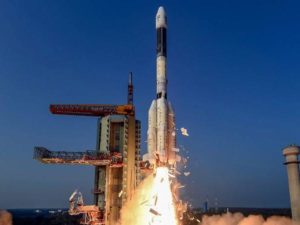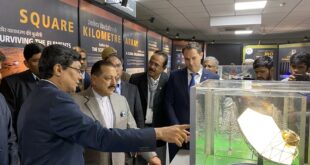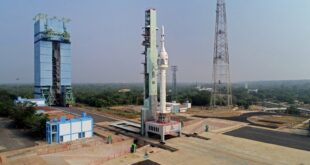
An Indian Space Research Organisation’s (ISRO) Geosynchronous Satellite Launch Vehicle (GSLV-F11) successfully launched the GSAT-7A military communication satellite from the Satish Dhawan Space Centre (SDSC) in Sriharikota, India, on 19 December 2018.
The GSLV-F11 lifted off from the Second Launch Pad at SDSC at 04:10 pm IST, carrying the 2250 kg GSAT-7A and, about 19 minutes later, injected GSAT-7A into a Geosynchronous Transfer Orbit (GTO) of 170.8 kilometres x 39127 km, which is very close to the intended orbit.
A team led by ISRO Chairman Dr. K. Sivan oversaw the launch proceedings.
Soon after the separation of the satellite, ISRO’s Master Control Facility (MCF) at Hassan in Karnataka took over the command and control of GSAT-7A. As of the writing of this report the satellite’s health parameters were normal.
In the next few days, scientists at MCF will perform various orbit-raising manoeuvres, using GSAT-7A’s onboard propulsion system, to place the satellite in its final geostationary orbit.
In his post-launch televised address, Dr. Sivan said the team has achieved another spectacular milestone by launching GSAT-7A.
“In the last 35 days, ISRO has successfully launched three missions from SDSC starting with GSLV MkIII-D2 on November14, PSLV-C43 on November 29 and finally GSLV-F11 today. GSLV has successfully injected GSAT-7A into a super synchronous transfer orbit,” Dr. Sivan said.
He said GSAT-7A is the heaviest satellite to have been launched by the GSLV with an indigenously developed cryogenic stage.
“The cryogenic stage of this vehicle has been modified to increase the thrust rate. GSAT-7A is an advanced communication satellite with a Gregorian Antenna and many other new technologies. The testing and realisation of this satellite has been carried out meticulously by ISRO team. We have signed off year 2018 on a high and positive note,” Dr. Sivan added.
GSAT-7A is an advanced military communications satellite meant exclusively for the Indian Air Force (IAF), and was developed in ISRO’s Satellite Centre. GSAT-7A is similar to the Indian Navy’s GSAT-7 and the Indian Air Force will be the sole operator of the satellite.
GSAT-7A will enable the IAF to interlink different ground radar stations, ground bases, and airborne early warning and control (AWACS) aircraft such as the Beriev A-50 Phalcon and the DRDO AEW&CS. The satellite will enhance network-centric warfare capabilities of the Indian Air Force and therefore enhance its global operations. The satellite will also be used by the Indian Army’s Aviation Corps for its helicopters and unmanned aerial vehicle (UAV) operations. India is in the process of acquiring high-altitude and long endurance satellite-controlled UAVs, such as the U.S. Predator-B and Sea Guardian that can launch stand-off weapons at enemy targets from long distances.
To boost its network-centric operations, the IAF is also likely to get another satellite, GSAT-7C, within a few years. The payload of the GSAT-7A consists of 10 Ku-band transponders.
GSAT-7A is the 39th Indian communication satellite built by ISRO to provide services to its IAF users in Ku-band over the Indian region. Most of the functional requirements of the communication payloads and the other systems have been derived from ISRO’s earlier geostationary INSAT/GSAT satellites.





